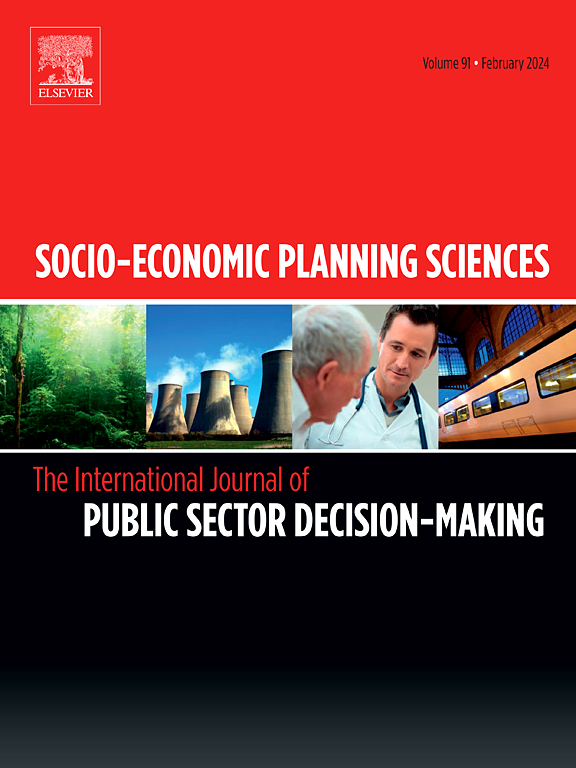基于TOPSIS-DEA方法的多期产能利用率测度:以林业为例
IF 5.4
2区 经济学
Q1 ECONOMICS
引用次数: 0
摘要
产能过剩已经成为一个全球性的挑战,它限制了资源配置效率,阻碍了工业的可持续发展。因此,准确测量容量利用率(CU)是必要的。为了满足这一需求,我们提出了一种新的多周期CU测量模型,该模型集成了TOPSIS (Order Preference Technique for Order Preference by Similarity To Ideal Solution)和DEA (Data Envelopment Analysis)方法。该模型首先构建正生产可能性集和负生产可能性集,整合决策单元(dmu)在不同时期的最佳和最差生产状态。利用对偶理论和多目标规划理论,证明了Pareto最优等价于DEA效率。这种等效性是定义基准的基础,并确保其科学有效性。在此基础上,建立了正、负CU测量模型,并结合TOPSIS相对接近度概念构建了一个复合CU指标。为了证明该模型的适用性,我们使用了中国31个省份2011-2020年的林业部门数据,并以传统方法为基准进行了验证。结果表明,基于基准的效率评估提高了排名的可靠性,并允许跨时期的比较。此外,新的CU指标同时反映了dmu的正调整和负调整需求,为CU提供了更全面和客观的评估。本研究为产能调控提供了更为精准的量化工具,对促进产业结构调整和可持续发展具有重要的理论和实践意义。本文章由计算机程序翻译,如有差异,请以英文原文为准。
Multi-period capacity utilization measurement using a TOPSIS-DEA approach: A case study of the forestry industry
Excess capacity has emerged as a global challenge, limiting resource allocation efficiency and hindering sustainable industrial development. Accurate measurement of capacity utilization (CU) is therefore essential. To meet this need, we propose a new multi-period CU measurement model that integrates the TOPSIS (Technique for Order Preference by Similarity to Ideal Solution) and DEA (Data Envelopment Analysis) approaches. The model first constructs positive and negative production possibility sets, integrating the best and worst production states of decision-making units (DMUs) across periods. Using duality theory and multi-objective programming theory, Pareto optimality is proven to be equivalent to DEA efficiency in these sets. This equivalence serves as a foundation for defining benchmarks and ensures their scientific validity. Building on this foundation, positive and negative CU measurement models are developed, integrating the TOPSIS concept of relative closeness to construct a composite CU indicator. To demonstrate its applicability, the model is implemented using forestry sector data from 31 Chinese provinces for the period 2011–2020 and benchmarked against traditional methods. The results show that the efficiency evaluation based on the benchmark improves ranking reliability and allows comparisons across periods. Furthermore, the new CU indicator captures both positive and negative adjustment needs of DMUs, providing a more comprehensive and objective assessment of CU. This study provides a more precise quantitative tool for capacity regulation, offering important theoretical and practical implications for promoting industrial restructuring and sustainable development.
求助全文
通过发布文献求助,成功后即可免费获取论文全文。
去求助
来源期刊

Socio-economic Planning Sciences
OPERATIONS RESEARCH & MANAGEMENT SCIENCE-
CiteScore
9.40
自引率
13.10%
发文量
294
审稿时长
58 days
期刊介绍:
Studies directed toward the more effective utilization of existing resources, e.g. mathematical programming models of health care delivery systems with relevance to more effective program design; systems analysis of fire outbreaks and its relevance to the location of fire stations; statistical analysis of the efficiency of a developing country economy or industry.
Studies relating to the interaction of various segments of society and technology, e.g. the effects of government health policies on the utilization and design of hospital facilities; the relationship between housing density and the demands on public transportation or other service facilities: patterns and implications of urban development and air or water pollution.
Studies devoted to the anticipations of and response to future needs for social, health and other human services, e.g. the relationship between industrial growth and the development of educational resources in affected areas; investigation of future demands for material and child health resources in a developing country; design of effective recycling in an urban setting.
 求助内容:
求助内容: 应助结果提醒方式:
应助结果提醒方式:


